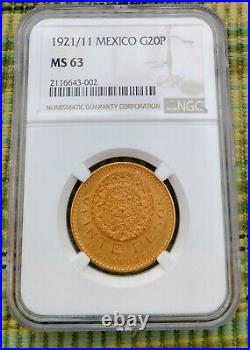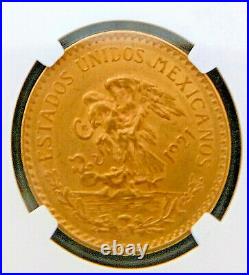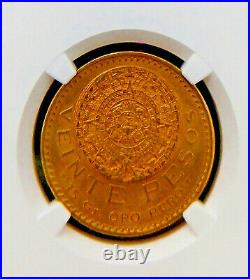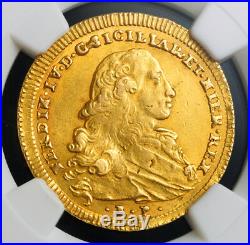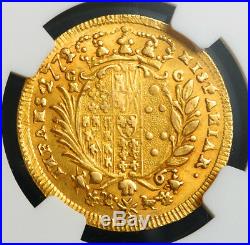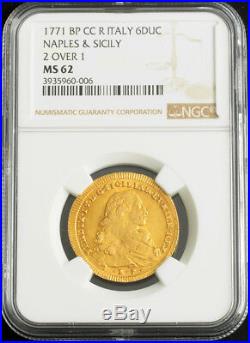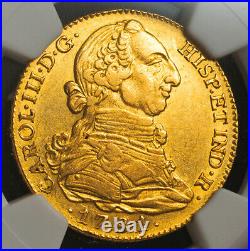



1781/79, Spain, Charles III. Large Gold 4 Escudos Coin. Denomination: Gold 4 Escudos Mint Place: Madrid (crowned M) Reference: Friedberg 284, CT-306, KM-418.1. Certified and graded by NGC as AU-55! Assayers: P edro Remigio Gordillo and J ose de Villaviciosa (PJ) Mint Year: 1781. According to NGC the last two digits re-ngraved from 79, which indicate the usage of the modified 1779 dies for the striking of this issue! 875 Diameter: 30mm Weight: 13.5gm. Obverse: Profile bust of Charles III right with long hair, wearing Toison d’or Order. Charles III by the Grace of God, King of Spain, 1781/79. Reverse: Crowned oval spanish shield with arms Castile (Castle) and León (Lion). All within Toison d’or Order. Under the auspices of God there is happiness on both sides. Charles III (January 20, 1716 December 14, 1788) was King of Spain 170088 (as Carlos III), King of Naples and Sicily 173559 (as Carlo VII and Carlo V), and Duke of Parma 173235 (as Carlo I). He was a proponent of. Charles was the first son of the second marriage of Philip V with Elizabeth Farnese of Parma. At the age of sixteen he was sent to rule as Duke of Parma by right of his mother. On December 1, 1734 following Montemar’s victory over the Austrians at Bitonto, he made himself master of Naples and Sicily by arms. Charles had, however, no military tastes, seldom wore uniforms, and could only with difficulty, be persuaded to witness a review. The peremptory action of the British admiral commanding in the Mediterranean at the approach of the War of the Austrian Succession, who forced him to promise to observe neutrality under a threat to bombard Naples, made a deep impression on his mind. It gave him a feeling of hostility towards the Kingdom of Great Britain which, in after-times, influenced his policy. As King of Naples and Sicily, Charles began there the work of internal reform which he afterwards continued in Spain. Foreign ministers who dealt with him agreed that he had no great natural ability, but he was honestly desirous to do his duty as king, and he showed good judgment in his choice of ministers. The chief minister in Naples, Tanucci, had a considerable influence over him. It was during his rule that the Roman cities of Herculaneum (1738), Stabiae and Pompeii (1748) were re-discovered. The king encouraged the excavations and was informed about the findings even after moving to Spain. On August 10, 1759, his half-brother Ferdinand VI of Spain died, and Charles III left the Neapolitan/Sicilian dominions to go to Madrid. His second son would eventually rule in Spain as Charles IV. His third son would unify the Kingdom of Naples and Kingdom of Sicily to form the Kingdom of the Two Sicilies and ruled as Ferdinand. As king of Spain, his foreign policy was marked by the alliance with France (the Family Compacts) and the conflict with Britain over the control of the American possessions. His support for France in the close of the Seven Years’ War led to the loss of Florida to the British, although this was partly compensated by the acquisition of the French Louisiana. The rivalry with Britain also led him to support the American revolutionaries in their War of Independence despite his misgivings about the example it would set for the Spanish Colonies. During the war, Spain recovered Minorca and Florida, but failed to capture Gibraltar. His internal government was, on the whole, beneficial to the country. He began by compelling the people of Madrid to give up emptying their slops out of the windows, and when they objected he said they were like children who cried when their faces were washed. In 1766, his attempt to force the. To adopt the French dress for public security reasons was the excuse for a riot. During which he did not display much personal courage. For a long time after, he remained at Aranjuez, leaving the government in the hands of his minister Pedro Pablo Abarca de Bolea, Count of Aranda. Not all his reforms were of this formal kind. Charles was a thorough despot of the benevolent order, and had been deeply offended by the real or suspected share of the Jesuits in the riot of 1766. He therefore consented to the expulsion of the order, and was then the main advocate for its suppression. His quarrel with the Jesuits, and the recollection of some disputes with the Pope he had had when King of Naples turned him towards a general policy of restriction of what he saw as the overgrown power of the Church. The number of reputedly idle clergy, and more particularly of the monastic orders, was reduced, and the Spanish Inquisition, though not abolished, was rendered torpid. In the meantime, much antiquated legislation which tended to restrict trade and industry was abolished; roads, canals and drainage works were established. The result was largely due to the king, who even when he was ill-advised did at least work steadily at his task of government. He created the Spanish Lottery and introduced Christmas cribs following Neapolitan models. During his reign, the movement to found “Economic Societies” (a rough prototype Chamber of Commerce) was born. His example was not without effect on some of the nobles. In his domestic life King Charles was regular, and was a considerate master, though he had a somewhat caustic tongue and took a rather cynical view of humanity. He was passionately fond of hunting. During his later years he had some trouble with his eldest son and daughter-in-law. If Charles had lived to see the beginning of the French Revolution he would probably have been frightened into reaction. As he died on the 14th of December 1788 he left the reputation of a philanthropic and philosophic king, still nicknamed “el rey alcalde” (“the king mayor”) because of the public works in Madrid. In spite of his hostility to the Jesuits, his dislike of friars in general, and his jealousy of the Spanish Inquisition, he was a very sincere Roman Catholic. Charles was responsible for granting the title “Royal University” to the University of Santo Tomas in Manila which is the oldest in Asia. The item “1781/79, Spain, Charles III. Large Gold 4 Escudos Coin. Overdate! NGC AU-55″ is in sale since Saturday, June 26, 2021. This item is in the category “Coins & Paper Money\Coins\ World\Europe\Spain”. The seller is “coinworldtv” and is located in Wien. This item can be shipped worldwide.
- Composition: Gold
- Country/Region of Manufacture: Spain
- Certification: NGC
- Denomination: 4 Escudos
- KM Number: 418.1.
- Grade: AU 55
- Year: 1781

